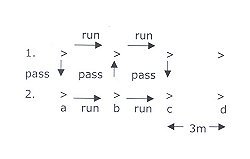
Rough play is popular among this age group and can be a useful way of fine-tuning physical skills. This is the time to encourage social, intellectual and physical development as learning the basic skills lays the foundation for grasping more complicated sports and activities.
Rugby activities for four to five-year olds
The four to five-year-olds can practise the basic skills of rugby as suggested below. It is important for the child to have much success and fun while doing the exercises.
The following pieces of equipment will be required: a large plastic ball, a size 3 Rugby ball, and flat beacons. These activities would be best executed on a field but the back garden will suffice. These activities have been selected so that they can be practised with Dad, Mom and siblings.
Skills:
- Ball handling
- Running with the ball
- Passing
- Catching
- Picking up/putting down ball while running
- Kicking (Punt and Place kick)
Ball handling:
1. Use large plastic ball, stand with feet wide apart and roll ball in and out between the feet in the figure of eight.
2. Use rugby ball (size 3) and pass it around own waist without dropping it.
Practical suggestion: Make activities fun by saying that Spiderman wants to spin a web around their feet and waists – see how many times the web can go round without dropping it - challenge them.
Running with ball:
Partners stand 10 m apart, one with and one without ball. On the count of 3 they run towards each other, give the ball into the hands of the partner and run to the opposite end.
Practical suggestion: Hold the ball on the side that the partner runs by on – make it easy for your partner.
Passing:
1. Work with a partner - place four sets of cones 2 m apart at intervals of about 3m (see below). Partner 1 passes to partner 2 at (a), they run to (b) and then partner 2 passes back to 1, they run to (c) and 1 passes back to 2 and so on. Start off using the plastic ball and then introduce the rugby ball.
Practical suggestion: Rugby is a team sport so you need to make things easy for your partner. Pass the ball from your hip and aim for your partner’s belly button. Watch partner throughout and expect the ball at the next set of holders. As a challenge, the partners could see how many times they can do this without dropping the ball or they can time themselves and see how quickly they can complete the task. When the rugby ball is introduced, show the child how to grip the ball properly. Important to turn head and shoulders to look at partner as he passes.
Catching:
1. High lobbed balls – parent stands 2 m away and throws ball with an arc into the arms of the child. The child holds arms like an ice cream scoop and squeezes the ball once it is safely in his arms.
Practical suggestion: Start off using the plastic ball and make it easy for the child. Later introduce the rugby ball but make sure that the ball is thrown into the arms. As they progress, teach them to run and move in under the ball – vary the height of the arc.
2. Waist high balls – teach child to watch, expect and stretch hands out to oncoming ball.
Practical suggestion: Pass ball to the left and right side of the child. Increase the distance between parent and child as they progress. Also challenge them by seeing how many catches out of ten are caught successfully.
Picking up and putting down of ball:
1. Partners stand 10 m apart, place two balls half way between them. On the count of 3 they run towards balls, pick one up and run to their partner’s place and put ball down as one would when scoring a try.
Practical suggestion: Make it challenging by seeing who can pick up the ball and get to their partner’s spot first (shout, “try” when ball is dotted down)
Kicking:
1. Punt kick – hold plastic ball between hands and lean forward, best foot back, drop ball and kick it before the ball hits the ground.
Practical suggestion: Introduce the rugby ball only later on - teach them to kick the ball on the rounded part of the ball and not on the pointed sides (shoes to be worn if the foot stings). Challenge the child by seeing how far and high they can kick the ball. Later introduce a target for them to kick at e.g. into the parent’s arms/a circle of beacons etc.
2. Place kick - place plastic ball on holder, take two steps back and kick ball off holder.
Practical suggestion: Teach the child to kick the ball on the spot where the ball rests on the beacon (i.e. under the ball - in order to gain height) and also to keep their heads down while kicking. Introduce the rugby ball later – cut a larger hole in the top of one of the beacons to stabilise the ball. Challenge the child by pasting strips of masking tape resembling a set of rugby posts on the garage door. Let them try and kick the ball over and through the “posts”. Place the ball in different spots to make it more difficult or easier for them.
Activities supplied by Playball. Click here for more information on Playball.
(Health24, August 2011)
(Reviewed by Anne van Niekerk, Playball, September 2011)
Read more:
Rugby skills for 6 - 8 year olds
Rugby skills for 9 - 10 year olds
Rugby skills for 11 - 12 year olds
Rugby skills for 13 - 18 year olds




 Publications
Publications
 Partners
Partners















